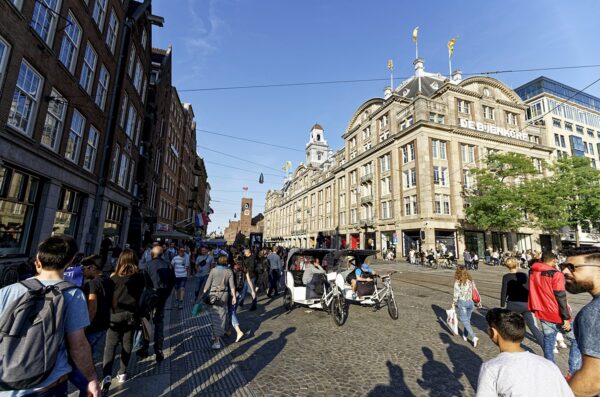Whilst many British retailers have welcomed measures such as rates relief, which might just enable them to survive the trauma of closing up for months this spring, across the pond some 47,000 American stores have pulled down their shutters and virtually all US retailers have informed landlords they will withhold or slash rents.

For some stores in the UK and Europe – in particular supermarkets, pharmacies and DIY stores – the crisis has resulted in an unseasonal boom, whilst for others, such as garden centres and nurseries, the crisis could not have come at a worse time. Ornamental plant growers are facing the loss of their entire 2020 income as they are forced to throw away disposable stock and the Horticultural Trade Association is pleading for £250million of Government support to avoid a total industry collapse.
The picture across the Atlantic is even more grim. By the second week of March, U.S. retail traffic was already down more than 30 percent year-on–year, according to data from Cowen.
The knock-on effect of crisis is reverberating through all corners of the global retail trade, with major exhibitions in the UK, EU, America and Asia cancelled, postponed or optimistically vowing to co-locate with complementary shows in Autumn. Convention centres and exhibitions halls from London through Birmingham to Harrogate have been repurposed as hospitals in developments so swift and shocking they are bordering on the surreal.
Many retailers have entered the pandemic with a weak balance sheet and lots of debt. Some are far more vulnerable than others. Here in the UK Laura Ashley entered into administration citing the coronavirus as the culprit, although the company had, in reality, been struggling for years. Furniture retailer Lombok has also just announced that it has gone into administration for the third time in 11 years and made all its 43 staff redundant. John Lewis has closed all its stores for the first time in its 155 year history, but many staff have been redeployed to Waitrose, where panic-buying of food has boosted the grocery sector in general. The John Lewis website — “which generates half the brand’s business” — will continue to operate as normal.
Forbes expects to see what it calls “a great retail bifurcation” emerging, where a few retailers selling high demand pandemic necessities are relatively non impacted by the economic effects of the pandemic (Amazon winning again). Online sales at general-merchandise retailers climbed 50 percent on March 13, according to Rakuten Intelligence and some of these retailers are aggressively hiring to meet demand, increasing employee pay and boosting supply chains. They could well emerge with record quarterly growth whilst other businesses are left in the wildnerness.
“In the space of a week, the retail landscape has changed from being fairly normalised to being absolutely disrupted beyond what we’ve ever seen before outside of the Second World War,” commented Neil Saunders, managing director of GlobalData Retail. Whilst there is hope that after all this is over the shopping landscape will quickly normalise, there are also concerns that a traumatised and fearful public might never quite get over the social distance conditioning they’re currently being forced to adopt.
Retailers of non-essential products will bear the brunt of the economic impact, with apparel and footwear shops at risk alongside regular gift and stationery retailers who don’t have robust online offerings. Many independent businesses are unprepared for a significant lapse in cash flow, a sad situation which rings equally true for suppliers as well as their retail customers. The most dreaded scenario is for a tiny proportion of retailers to emerge stronger than ever whilst specialty stores and other independents cease to exist in the near future, although – as already mentioned – it is certain that local communities will rally to protect the shops they value the most at any opportunity.
All retailers and brands have been faced with a daunting array of challenges, ranging from employment issues – including stringent health and safety measures – through to supply chain logistics, cash flow and a transformed set of consumer demands and circumstances. Fashion and lifestyle brands are offering steep discounts online in a frantic push to move stock as inventories pile up due to store closures and a fall in sales of up to 70%. Some are using the #KeepTheLoveAlive! hashtag in a bid to entice shoppers trapped at home into online purchasing.
Even when we emerge from this crisis it will be to a radically different economic landscape. The transition to digital commerce is now on steriods and embracing more sectors than ever before, despite consumers putting strong brakes onto discretionary spending. For a glimpse of the possible future consider that, prior to the SARS outbreak in 2003, Alibaba was primarily a B2B e-commerce site doing approximately $10 million a year and is now looking at some $53 billion p.a.
On the other hand, here in the UK the difficulty of finding a delivery slot, coupled with longer wait times, mean consumers might lose faith with online ordering systems and start hankering after the feelgood experience offered by trusty local independents, which might well be gifted with a huge opportunity when we’re on the other side of this crisis. There are already strong indications that customers are very keen to support their favourite local businesses wherever possible.
For many retailers on either side of the Atlantic, it remains to be seen whether a reprieve on a couple months’ rent or even an amnesty on business rates, will be enough to see them through the almost total destruction of their ability to trade.
British garden centres – for several years amongst the biggest stars of our retail trade – have been gutted sudden closure at what should be the start of their peak trading. The beautiful early spring weather which accompanied the UK’s lock down will have been bittersweet for businesses which would ordinarily have seen gardeners and allotment holders flocking through the doors to buy supplies and plants which have now died on the shelves. Bitter irony indeed that as the British public desperately searches for seeds which will enable them to finally grow their own, the shops which should have supplied them have been forced to close.
Online sellers of traditional garden centre products have benefitted from an early sales surge of up to 1,237% for tomato seeds and 1,096% for compost according to Amazon. Sales of cress seeds, salad leaves and courgette seeds rose by 619 per cent, 432 per cent and 318 per cent, respectively, whilst sales of potato growth bags climbed 168 per cent in one 24 hour period.
Home appliances such as bread makers are also winners, with stocks of the most popular models selling out completely around the UK. Home office and gym equipment have also been flying out of the warehouses, alongside vitamin supplements and antioxidants. DIY shops have been deemed essential and therefore have been able to remain open (another bitter pill for independent garden centres) and have benefitted from consumers forced to stay at home and who are now getting on with all those essential jobs which have been on hold for months or years.
Supermarkets and food shops, meanwhile, cannot truly rejoice from the gigantic spike in sales which resulted from the panic buying of supplies, but are under intense pressure to keep staff safe as customers’ tempers fray instore and some resorted to abusing long-suffering shelf-stackers and check-out staff. Retailers large and small, from Tesco through to independent high street butchers and bakers, have now put in place much stricter social distancing measures, with many smaller shops enforcing a policy of only two customers at a time entering their premises and supermarkets employing security staff at the front doors to keep customers out rather than in. Who would have thought such a day would ever come?
It is a question shared by our fellow shopkeepers in America, a country that contains more retail selling space than any other. While most have pledged to remain closed for at least a fortnight, the fact is that most of them will almost certainly have to stay closed for much longer. British officials are already indicating that the lockdown will last until June and with America further behind the dreaded curve of coronavirus it seems likely that they will have to follow suit.
Whilst some American retail landlords have accepted that they will need to help smaller tenants, other landlords are themselves sitting on piles of debt, meaning that forbearing rent is not a viable option and could spell sudden death for their own businesses. It could even be the tipping point for America’s malls, many of which are in even deeper doldrums than their British counterparts.
Whilst facing up to the stark reality of the present day is essential for business owners, there is still hope, as companies set their creative juices onto maximum output in the search for solutions. Already we are seeing a huge rise in demand for the British manufacture of essential goods and can be sure that more will emerge as soon as the dust has settled on the present economic fallout. The real challenge for companies now is also a real opportunity to rise phoenix-like from the flames with new and improved business models which meet the twin demands of local reliance and strong sustainable credentials. Now is the time to reach for the drawing boards.
















